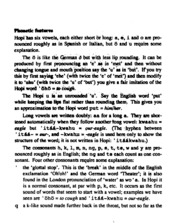
Hopi, Survey of an Uto-Aztecan Language PDF
Preview Hopi, Survey of an Uto-Aztecan Language
Hcpi hassix Vbwels, 6ich either short 6tfong: a, e, i and o are pfx>- iKMiDoed roughly as in Spanish or Italian, but 6 and u require some explanation. The 6 is like the Qfcrman d tnitVwitl^Jess lip rounding. It can be produced by first prpoouncifig an .«b in 'met* and then without changing UHigueand mouthjposttionsaythe 'u* as in 'bttt'. Ifymi try thisby fifstsaying 'ehe' (with twice the *e* oi'mtC)andthen inodify it10 'tthtt' (wtth twice the 'u' of'but') yougive ahit imitation ofthe The Hopi u is an unrounded V. ^y the English word 'put' while kaeping theHps flat ratherthan roundingthem. Thisgives you anapproximation lothe Hopi wofdput »him/her. Long vowels are written doubly: aa for a long a. They are shor- tened automatically whenthey follow anotherioiq;vowel: kwaahu « eagle but ' itMirl^^hu « qwr-<ag!U. (V^^ hyphen between ' it&£^ » Mfr% and -Icwahja ^ -eagle is used hereonly toshow the structureoftheword; it isnotwritten in Hopi: ' itIULkwahu.) The consonants h, k, 1, m, n» nq, p^ s, t» ta, w and y aip pro- nounced roughly as in English; the ng and ta eachcpuntasone con- sonant. Fourotherconsonantsrequire someexplanation: * the 'glotui stop'. This is the 'break' in the middle ofthe English exclamation 'Oh*oh!' and the German word 'Theater'; it is also found in the London prbhunciationof'water' asvo*a. In Hopi it is a normal consonant, at par with p, k, etc. It occurs as the first sound ofwords that seem tostart with avowel; examples we have seen are 'oho = tocough and * it&&-kwahu = our-eagle. q a k-like sound made furtherback in the throat, but notsofar asthe .5- Arabic'qof . The k inthe English 'awkwiird' isclose, r befofe a vbwel: a voiced 'sh', as in English 'measure'; elsewhere (b^fbit consonants and at word end) just like s; never like the EngNsh,American or Italianr. V bilabial* as in Spanish; proog^noed with the same lip positions as the Englishb. The k, ng and to some e^Lteiat the q have the property that they can be pr^no^pccd simultaneoii^y with a v (Mabialized^) or a y ^ing Cpalatized'), rise tofive ite^consonants: normal k ng q ngv qw labialized lew palatized ky ngy Agisin, each ofthese counts as a single consonant, in spite ofappear- ances. Hopi docs not distinguish bityyn voiced and voiceless con- sonants: theie is nob; d, g,amn^dyUll^ v,them isno f. A pattheb^ikmingof#mutA duMI^ttivi»HmmMdIt«fm^MOid: poosi^i^smed^mtmy^U}'^t€n^ exMifrie, in•ItkUi'^TOnl speach seed. Likeiwise, die vitll»end ofa woid ii pioaeMoad p by manyspeakers: 'evor *ep»alir. Stressis normallyonthefirstK^flW^ butmay^on thesecond if there are mc^ than two syilabftik lii^^ when tile first vowel is shoitand thesecoMistdhg: ' itii^klriihu ^ai#-i|2fe. When itis onthefirstsyllable, thfestress isnot^icated inthistext. Grune,Dick. 1991. Hopi, Surveyof anUto-Aztecan Language.Wales: CyhoeddwrJosephBiddulph.
